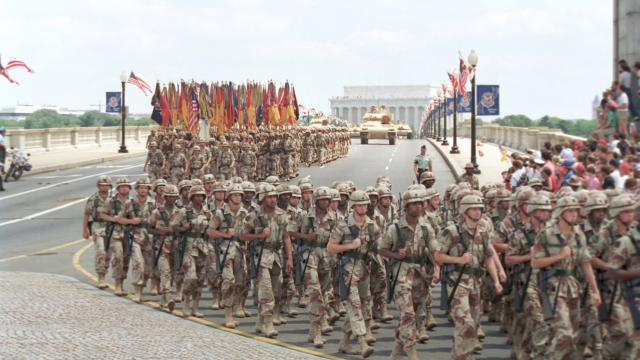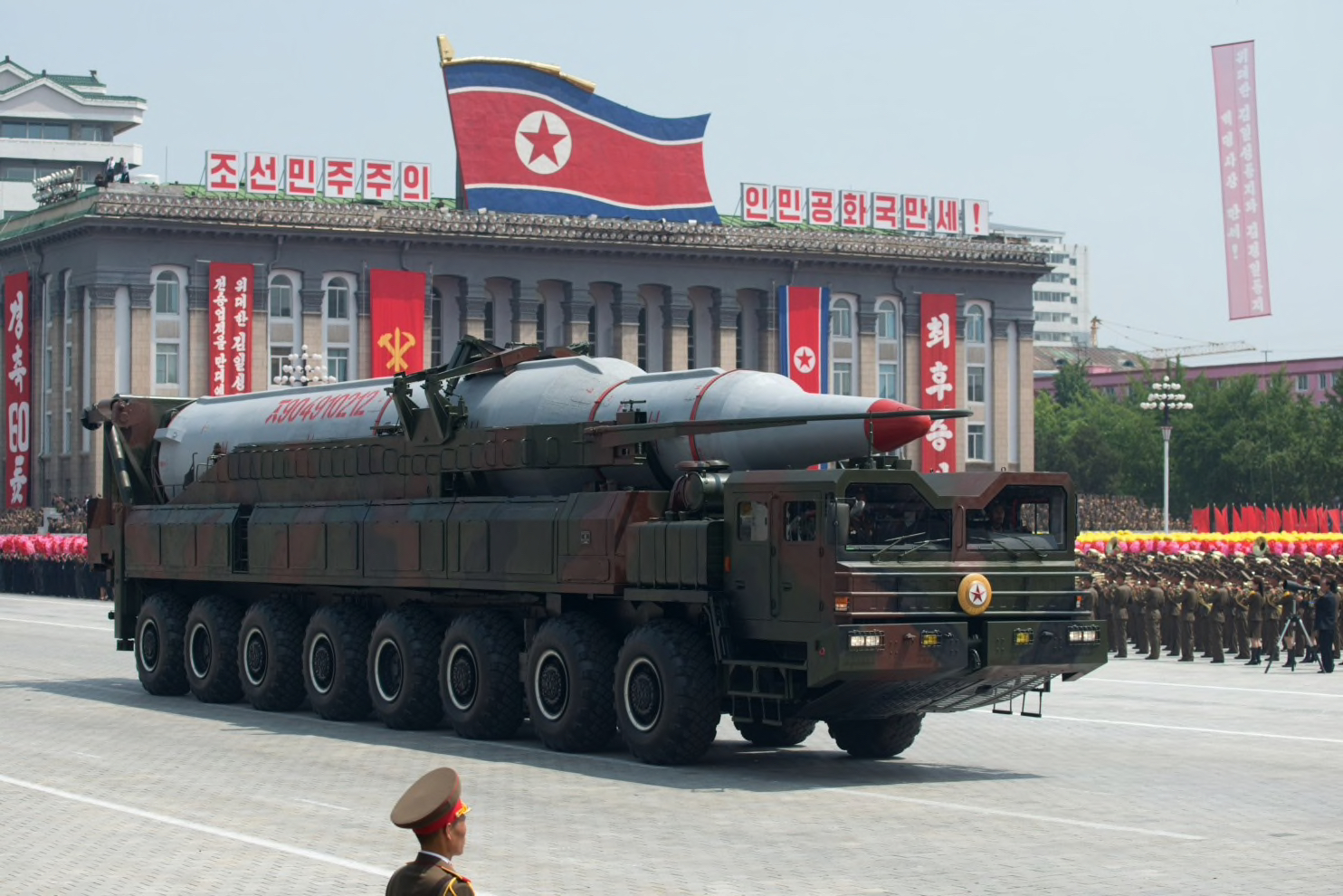
Troops march over Arlington Memorial Bridge as they head toward the Pentagon during the National Victory Day Parade on June 8, 1991. The parade celebrated the end of the Gulf War. (Doug Mills/Associated Press)
President Trump’s vision of soldiers marching and tanks rolling down the boulevards of Washington is moving closer to reality in the Pentagon and White House, where officials say they have begun to plan a grand military parade later this year showcasing the might of America’s armed forces.
Trump has long mused publicly and privately about wanting such a parade, but a Jan. 18 meeting between Trump and top generals in the Pentagon’s tank — a room reserved for top-secret discussions — marked a tipping point, according to two officials briefed on the planning.
Surrounded by the military’s highest-ranking officials, including Defense Secretary Jim Mattis and Joint Chiefs of Staff Chairman Gen. Joseph F. Dunford Jr., Trump’s seemingly abstract desire for a parade was suddenly heard as a presidential directive, the officials said.
“The marching orders were: I want a parade like the one in France,” said a military official who spoke on the condition of anonymity because the planning discussions are supposed to remain confidential. “This is being worked at the highest levels of the military.”
Shows of military strength are not typical in the United States — and they don’t come cheap. The cost of shipping Abrams tanks and high-tech hardware to Washington could run in the millions, and military officials said it was unclear how they would pay for it.
A White House official familiar with the planning described the discussions as “brainstorming” and said nothing was settled. “Right now, there’s really no meat on the bones,” said the official, who spoke on the condition of anonymity to describe internal discussions.
After The Washington Post first published this story, White House press secretary Sarah Huckabee Sanders issued a statement confirming that plans are underway.
“President Trump is incredibly supportive of America’s great service members who risk their lives every day to keep our country safe,” Sanders said. “He has asked the Department of Defense to explore a celebration at which all Americans can show their appreciation.”
The Pentagon also confirmed the plans following The Post’s initial report. “We are aware of the request and are in the process of determining specific details. We will share more information throughout the planning process,” Defense Department spokesman Thomas Crosson said in a statement.
The inspiration for Trump’s push is last year’s Bastille Day celebration in Paris, which the president attended as a guest of French President Emmanuel Macron. Trump was awestruck by the tableau of uniformed French troops marching down Avenue des Champs-Elysees with military tanks, armored vehicles, gun trucks and carriers — complete with fighter jets flying over the Arc de Triomphe and painting the sky with streaks of blue, white and red smoke for the colors of the French flag.
Aboard Air Force One en route home from Paris in July, aides said Trump told them that he was dazzled by the French display and that he wanted one at home.
It was still on his mind two months later when he met with Macron on the sidelines of the United Nations General Assembly in New York.
“It was one of the greatest parades I’ve ever seen,” Trump told reporters. “It was two hours on the button, and it was military might, and I think a tremendous thing for France and for the spirit of France.”
Seated next to Macron, Trump added: “We’re going to have to try to top it.”
Several administration officials said the parade planning began in recent weeks and involves White House Chief of Staff John F. Kelly, but they cautioned that it is in the preliminary stages. D.C. officials said they had not been notified of parade plans.
A date has not been selected, although officials said Trump would like to tie the parade to a patriotic holiday. Officials are weighing weather patterns as well as competing events, such as the massive annual Independence Day celebration on the Mall.
Trump officials had discussed Memorial Day on May 28, and July 4, but the Pentagon prefers Veterans Day on Nov. 11 — in part because it would coincide with the 100th anniversary of the victorious end of World War I and therefore be less associated with the president and politics. “That’s what everyone is hoping,” said the military official.
It is unclear what role Trump would play, whether he may perhaps serve as a grand marshal or observe the spectacle from a reviewing stand.
The location is still being discussed, though Trump has said he would like it to proceed along Pennsylvania Avenue, which links the Capitol and the White House. It would be the same route as Trump’s inaugural parade and pass by his family’s showpiece: Trump International Hotel.
Even before he was sworn in as president, Trump was dreaming of America’s war machine on display in front of the White House or Capitol.
“We’re going to show the people as we build up our military,” Trump said in an interview with The Washington Post before his inauguration. “. . . That military may come marching down Pennsylvania Avenue. That military may be flying over New York City and Washington, D.C., for parades. I mean, we’re going to be showing our military.”
But big military parades — even those launched with the best of intentions — carry risks and troublesome historical echoes.
With a few exceptions — such as President George H.W. Bush’s 1991 parade down Constitution Avenue celebrating victory in the Persian Gulf War — presidents have avoided displays of military hardware that are more associated in the American mind with the Soviet Union’s Red Square celebrations or, more recently, North Korean leader Kim Jong Un’s efforts to show off his Taepodong missiles.
“I don’t think there’s a lack of love and respect for our armed forces in the United States,” said Douglas Brinkley, a presidential historian at Rice University. “What are they going to do, stand there while Donald Trump waves at them? It smacks of something you see in a totalitarian country — unless there’s a genuine, earnest reason to be doing it.”
The White House official rejected the suggestion that some associate a military parade with strongmen, saying it would be a “celebration of the men and women who give us freedom.”
“That’s the opposite of a totalitarian government,” the official said.
Weaponry on the streets of Washington is not unheard of. Presidents Harry S. Truman and John F. Kennedy had military equipment during their inaugural parades, in 1949 and 1961 respectively, during key junctures in the Cold War, said Michael Beschloss, another presidential historian.
“Set against the backdrop of American history, it does seem to hark back to the harsh days of the Cold War,” Beschloss said. “Those parades were a counterpoint to the parades in front of Lenin’s tomb at Red Square . . . One reason the Soviets had those parades was to distract the world from the fact that the Soviet military was actually much weaker than the Soviets were claiming.”
But generally, the United States has shied away from parading its military assets, calculating that doing so was not necessary for the world’s preeminent superpower.
There is no law or regulation preventing Trump from putting on a military parade, but there are plenty of potential complications that military leaders are likely to raise with the president. One worry is practical: that 70-ton tanks built for the battlefield would chew up Pennsylvania Avenue blacktop.
The military might also want to weigh in on the kind of equipment on parade. One concern is that big displays of missile launchers might evoke Pyongyang-style nationalism more than American patriotism.
A parade would probably be interpreted as another stroke of nuclear gamesmanship. Tensions between North Korea and the United States have risen over the past year as Trump and Kim have taunted each other with playground nicknames and threats.
After Kim warned last month that he had a “nuclear button” on his desk, Trump replied: “Will someone from his depleted and food starved regime please inform him that I too have a Nuclear Button, but it is a much bigger & more powerful one than his, and my Button works!”
The White House official said a parade would have nothing to do with Trump’s feuds with Kim but would be designed as a broad show of strength to send a warning to all of America’s adversaries.
Then there are the domestic pitfalls. At a time when Mattis and his top generals have been complaining about the state of military readiness and lobbying Congress for more money, pulling equipment off line for a costly parade could send the wrong signal.
There are personal risks for Trump, as well. Although he attended a military high school, Trump did not serve in the armed forces, avoiding the draft during the Vietnam War by claiming bone spurs. Critics have called Trump disingenuous for basking in the military’s glory.
Honoring the troops without politicizing their service has long been a dilemma for presidents. President Barack Obama’s frequent focus on wounded troops fighting to resume their lives struck the wrong chord with some conservatives.
One of George W. Bush’s biggest blunders as president came in 2003 when he landed on an aircraft carrier bearing a “Mission Accomplished” banner to claim victory in the Iraq War.
Former aides say Bush would have loved a big parade, but they recognized a problem: The wars in Iraq and Afghanistan never ended. Such subtleties — the United States is now dropping bombs in seven countries — don’t seem to have factored into Trump’s calculations.
With the midterm elections approaching and Trump’s approval ratings at historic lows, the lure of honoring the troops is powerful.
“Who flipped the coin for the Super Bowl on Sunday?” asked Peter Feaver, a former Bush White House official and professor at Duke University. “It was Medal of Honor winners. Why? The military brings us together.”
But Feaver also issued a warning for Trump, who is known for his excesses.
“A military parade,” he said, “is the kind of thing that can easily be overdone.”
Originally published on the Washington Post
3 WAYS TO SHOW YOUR SUPPORT
- Log in to post comments














